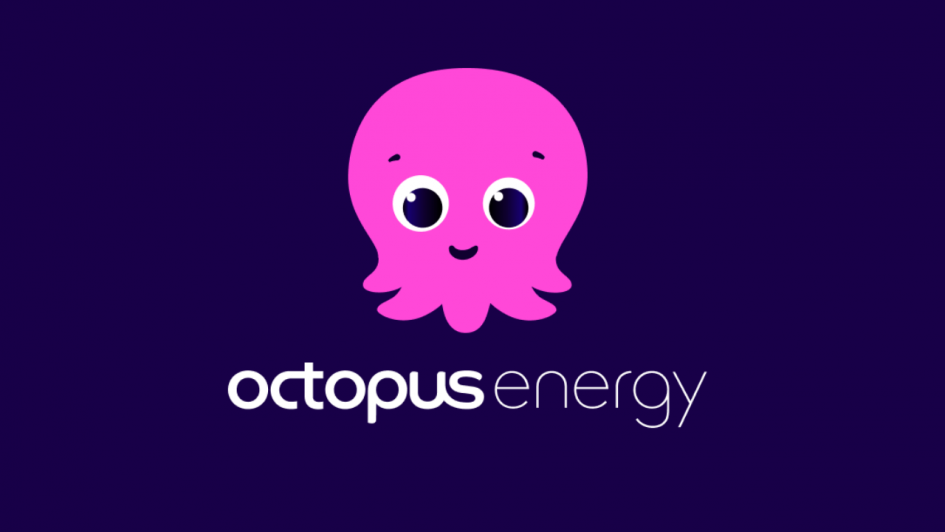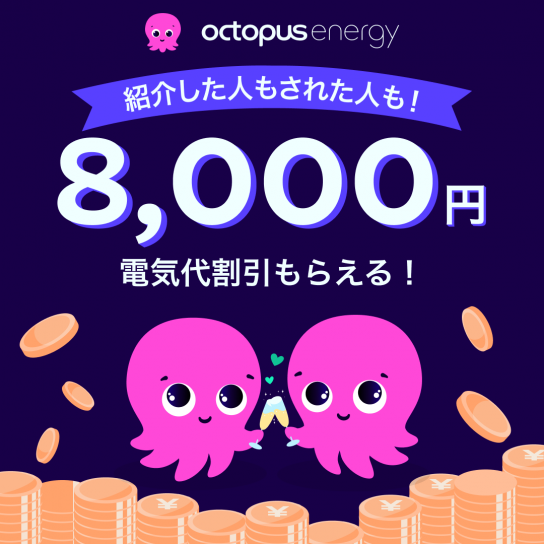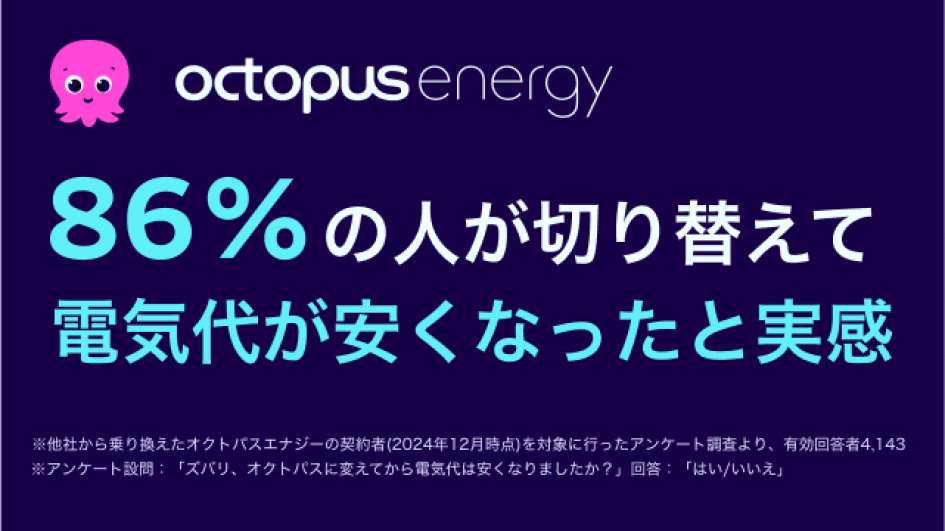Future of Renewable Energy for All
With Hajime Nakamura, President, Octopus Energy Japan
Welcome to the Eat Takeaway! In this series, we hear from leaders in business, branding, and marketing as they share their goals and challenges today and tomorrow.

As the world’s largest LNG (Liquified Natural Gas) importer, Japan’s energy landscape is at a pivotal crossroads. The country’s commitment to reducing fossil fuel dependence and achieving carbon neutrality by 2050 demands a major shift toward renewables which only make up 23% of Japan’s energy mix.
Clean energy is experiencing massive growth globally, surpassing 40% of electricity production for the first time in 2024. Across APAC, and particularly Japan, accelerating the adoption of renewable energy sources presents promising opportunities.
The 3 Key Quotes:
1. “In places like Houston, Texas, electricity demand peaks in the evening, which can overwhelm the grid. There, they’ve tested things like adjusting home thermostat settings to help ease the strain. Even small changes, when done collectively, can dramatically shift energy demand.”
2. “Referral campaigns on social media have also played a big role in growing the brand…A lot of traditional energy companies never really tapped into that digital word-of-mouth, so it’s given us a clear edge.”
3. “Sustainability is absolutely core to what we do—but when we look at what actually drives consumer decisions, price still comes out on top, whether in Japan or in the UK.”
Tazlu Endo: Please tell us about Octopus Energy and what the company does?
Hajime Nakamura: Octopus Energy is an electricity retailer focused on renewable energy. We launched in the UK in 2016 and, in just nine years, we’ve grown to become the country’s largest energy supplier, now serving over 7.3 million customers. Our approach is all about using cutting-edge technology to deliver smarter, more innovative energy services to customers at a lower price.
Globally, Octopus now operates in 18 countries, always with a focus on customer-friendly service and forward-thinking solutions. Here in Japan, we launched Octopus Energy Japan as a joint venture with Tokyo Gas in February 2021. I was with Tokyo Gas during the liberalization of Japan’s electricity market in 2016, and I’ve been able to apply that experience directly to helping get Octopus Energy Japan off the ground.

TE: How has Octopus grown so quickly in the UK and around the world?
HN: One of our biggest strengths is our proprietary tech platform, Kraken. It’s an in-house system that now supports over 60 million customer accounts around the world. The smooth, user-friendly experience Kraken delivers has really been a driving force behind our growth.
For the first few years, we had a relatively small share of the market. But things really took off around 2019. Just last year alone, around a million customers switched to us from other providers. From day one, the founding team has been focused on creating a truly customer-centric service. Our churn rate is extremely low—just 1–2%—and we consistently score high in third-party customer satisfaction surveys. A lot of our growth has come from word-of-mouth and referrals, which says a lot about how satisfied our customers are.
TE: You emphasize being able to provide cheaper energy. How are you able to offer renewable energy at such low prices?
HN: From the customer’s point of view, electricity should just work—you plug something in and expect it to be available. But behind the scenes, electricity is tricky because it can’t be stored easily. It has to be generated the moment it’s needed, which makes balancing supply and demand really important.
With renewables like wind and solar, you can’t control when they generate power like you can with fossil fuels. So instead of adjusting supply, we have to shift demand. One way we do that is through real-time campaigns—like sending app notifications when there’s an abundance of solar power during the day, letting customers know that electricity is cheaper and encouraging them to use more then. Our proprietary platform is what makes this kind of dynamic energy management possible.
TE: Can you give an example?
HN: In the UK, wind power is strongest at night, but if it’s not used, that energy just goes to waste. To make the most of it, we created a service called Intelligent Octopus Go for EV users. It automatically charges electric vehicles during the cheapest, most energy-abundant hours, usually overnight, at about a quarter of the regular electricity rate, making it more economical to run an EV than a gasoline car.
In Japan, the issue is a bit different. Here, we often have a surplus of solar power during the daytime. So we encourage customers with all-electric homes to use heat pumps to warm their bathwater during sunny hours. This kind of smart, real-time control of electricity usage is crucial to keeping renewable energy affordable—and it’s where Kraken, our tech platform, really shines.

TE: Are there regional differences in the challenges you face?
HN: In the UK, most wind farms are offshore in the North Sea, but demand is concentrated in southern England. So getting that energy where it’s needed requires really efficient long-distance transmission. In places like Houston, Texas, electricity demand peaks in the evening, which can overwhelm the grid. There, they’ve tested things like adjusting home thermostat settings to help ease the strain. Even small changes, when done collectively, can dramatically shift energy demand.
In Japan, solar power is the main source of renewables, but household electricity use tends to spike in the morning and evening—times when solar output is lower. Matching supply with demand and getting energy into major cities efficiently is a major challenge. That’s why we’ve introduced plans like Solar Octopus, All-Electric Octopus, and EV Octopus to help smooth out demand and ensure we’re effectively delivering 100% renewable electricity.
TE: How does Octopus present itself to customers?
HN: Our friendly pink octopus mascot Constantine and bold, catchy ads are all about showing that we’re fun and approachable. We want to show that we’re an affordable, eco-friendly energy company that offers customers something new and valuable. In the UK, referral campaigns on social media have also played a big role in growing the brand. What’s been key is that we consistently score highly in consumer surveys like Which and Trustpilot. People might think, “I’ve never heard of this energy provider, but it’s cheap and the reviews are great,” and give us a try. They then end up preferring us to their old provider. That kind of positive buzz spreads online and helps us bring in new customers organically. A lot of traditional energy companies never really tapped into that digital word-of-mouth, so it’s given us a clear edge.

TE: Why do you lead with affordability over other messages like sustainability or innovation?
HN: Sustainability is absolutely core to what we do—but when we look at what actually drives consumer decisions, price still comes out on top, whether in Japan or in the UK.
Over the past couple of years, global energy prices have spiked, and in the UK, it’s become a serious issue. For low-income households during winter, saving money becomes a matter of survival. That’s why we’ve chosen to lead with our ability to offer cheaper rates, while still being green. Our slogan “Cheaper, Greener Energy” reflects that priority.

TE: What’s the key to building a successful customer-facing brand?
HN: A strong brand isn’t just about what a company says, but about how a customer experiences it. For us, there are two essentials: first, customers need to genuinely enjoy using our service. Second, they need to enjoy it enough that they want to share with others. When someone thinks, “This is actually really good,” and goes on to share it with their friends or family, that’s how a brand grows its value and legacy.
The experience itself has to feel fair, and that starts with transparent pricing. We don’t just say our rates are low—we explain why they’re low. That level of openness builds trust.
A lot of traditional utilities still operate like infrastructure providers, not customer-facing retailers. Their typical response to pricing questions is “Read the fine print.” We’re the opposite. Our team is more like a concierge—ready to answer questions and solve problems for our customers. That, combined with smart tech and a customer-first mindset, is what truly sets us apart.
TE: What are your goals for the Japanese market?
HN: With fossil fuel prices continuing to climb globally, electricity is only going to get more expensive—especially for countries like Japan that import. That’s why we’re focused on delivering affordable, domestically generated energy to as many people as possible. One way we’re doing that is by offering plans that let customers install rooftop solar panels at no cost.
Since the Industrial Revolution, energy and food have been the driving forces behind human progress. To sustain life without fossil fuels, we need to discover smarter ways of utilizing renewable energy.
We launched Octopus Energy Japan during COVID, and we’re now supplying power to around 370,000 customers across the country, excluding Okinawa. It’s a big milestone, but we’re just getting started. We’ll keep developing fun, easy-to-use, and cutting-edge services—because we want to be the go-to green energy provider in Japan for as many people as possible.
Identify your core proposition: Octopus Energy leads with a simple, compelling message—affordable electricity. By prioritizing price, they draw users in and win them over with a great customer experience.
Customer-centricity is the key to growth: With one of the lowest churn rates in the industry, Octopus’s focus on customer satisfaction speaks for itself. High ratings and strong word-of-mouth continue to fuel steady growth.
Trust through responsiveness: Clear, real-time communication, fast support, and transparent pricing help Octopus build trust. Their commitment to fair pricing, openness, and quick response are key differentiators from their competition.
If you enjoyed this piece, subscribe here to The Eat Digest - our monthly newsletter covering our latest insights, Japan brand and marketing news, and much more!